Daily Current Affairs for UPSC 16th Oct 2025



| Index |
| S.No | Topic | Page No |
| Daily Hindu Analysis (YouTube) |
| 1. | Navigating the Global Economic Transformation |
|
| 2. | The Future of the IMEC |
|
| 3. | Why is the Fiscal Architecture of Municipalities Flawed? | |
| 4. | Trade Deficit Widens 93% in Sept. as Services Slump | |
| 5. | Night Light Data from 2013 and 2023 Reveals Limited Urban Growth in Bihar |
|
| 6. | Aquaculture Model of Sundarbans Wins FAO Recognition |
|
| 7. | China Files WTO Complaint on India’s EV, Battery Subsidies |
|
| Daily Current Affairs (App) |
| 8. | Live Cases Dashboard of the Legal Information Management and Briefing System (LIMBS) |
|
| 9. | Blue Flag Certification |
|
| 10. | India Elected for United Nations Human Rights Council (UNHRC) |
|
| 11. | National Critical Mineral Stockpile (NCMS) |
|
| 12. | Mission Drishti |
|
Navigating the Global Economic Transformation
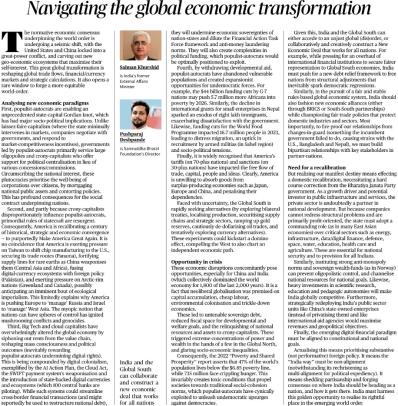
Syllabus Mapping:
- GS Paper 2 – International Relations:
- Global economic institutions, South–South cooperation, and India’s foreign policy in a multipolar world.
- GS Paper 3 – Economy:
- Globalisation, inclusive growth, and macroeconomic challenges.
Context: The global economic order is undergoing a seismic transformation, with the U.S. and China locked in a contest for global economic and technological dominance. This realignment is reshaping trade flows, financial systems, and strategic alliances, offering a critical opportunity for countries like India and the Global South to advocate for a more equitable and multipolar economic order.
What is it all about:
The article discusses how populist economic paradigms, declining globalization, and shifting financial power centers are transforming the foundations of the world economy. It emphasizes the need for nations, particularly in the Global South, to adopt coordinated strategies to navigate these shifts while preserving sovereignty, promoting inclusivity, and restructuring global financial norms.
Analysing the New Economic Paradigms:
1. Rise of State Capitalism and Populist Autocrats:
- Across the world, leaders are promoting a hybrid model of state capitalism, where governments actively intervene in markets, favoring politically connected corporations (“crony capitalists”).
- This leads to political centralisation and erosion of democratic accountability, as state assets and policies are mortgaged to serve corporate or political interests.
- Populist regimes, in turn, use such arrangements to consolidate power, weaken institutional checks, and suppress dissent.
2. Decline of Neoliberal Globalisation: - The long-standing neoliberal order — characterized by free trade, deregulation, and capital mobility — is under strain.
- The U.S. is recalibrating its strategy to secure domestic manufacturing and reduce dependence on global supply chains (e.g., CHIPS and Science Act, Inflation Reduction Act).
- China is responding with its own state-led industrial strategy and deepening ties across the Global South through initiatives like the Belt and Road Initiative (BRI).
3. Weaponisation of Trade and Finance: - Economic tools such as sanctions, export controls, and tariffs are now central to global diplomacy.
- For instance, the U.S. sanctions on over 30 countries and tariffs on 70+ nations have disrupted the flow of capital, goods, and technology.
- This weaponisation of finance has created new blocs and prompted the search for alternative payment systems and de-dollarisation efforts by the Global South.
4. Decline in Developmental Aid and Rising Inequality: - Reduction in international grants and funding (for example, cuts to the World Food Programme and aid for small enterprises) is pushing millions into poverty.
- As developed nations reduce aid commitments, new opportunities arise for countries like India to build South–South cooperation frameworks focusing on self-reliance and capacity-building.
Global South’s Opportunity in Crisis: The present uncertainty presents a strategic opening for the Global South to: - Reimagine global economic governance through reforms in institutions like the IMF, World Bank, and WTO.
- Promote collective resilience via regional trade networks, digital finance, and renewable energy collaborations.
- Push for the restructuring of sovereign debt and advocate for a new financial architecture that prioritises equitable growth and climate justice.
- Advance alternative trading arrangements and non-dollar payment mechanisms, strengthening autonomy from Western-led financial systems.
India’s Role: - India, as a key member of the Global South, can lead in building a New Economic Deal that promotes equity and sustainability.
- Through platforms such as G20, BRICS, and the International Solar Alliance (ISA), India can champion reforms in:
- Global taxation systems.
- Debt restructuring frameworks for developing economies.
- Trade diversification and regional self-sufficiency.
- India’s strategic neutrality, demographic dividend, and expanding digital economy provide leverage to act as a bridge between developed and developing worlds.
Way Forward: 1. Recalibration of Domestic and Global Policies: Rebalance fiscal priorities toward infrastructure, green technologies, and social protection. o Encourage public–private partnerships that align with sustainable development.
2. Building Economic Coalitions: Strengthen cooperation among South and Southeast Asian nations, Africa, and Latin America through frameworks like IBSA, BRICS+, and BIMSTEC.
3. Reform Global Financial Governance: o Democratise voting rights within the IMF and World Bank. o Advocate for transparent, inclusive, and representative multilateralism.
4. Promoting De-Dollarisation and Economic Sovereignty: o Encourage regional currency settlements and cross-border payment systems such as UPI linkages and digital currencies.
Significance:
- Reflects the ongoing shift from unipolar to multipolar economics.
- Marks a decisive moment for developing nations to influence the norms of trade, finance, and technology.
- Highlights the need for balanced growth, reduced inequality, and sovereign economic autonomy in shaping a just world order.
UPSC Mains: Q. “The global economic transformation presents both opportunities and challenges for India and the Global South. Discuss how India can leverage this transformation to promote a more equitable world order.”
The Future of the IMEC
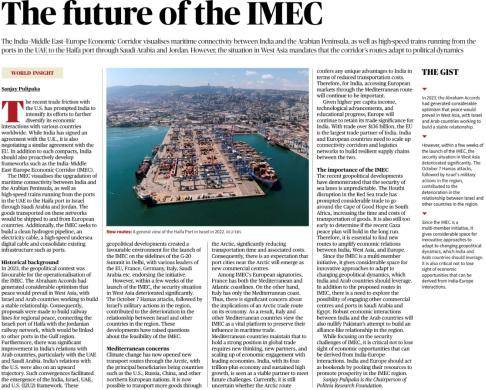
Syllabus Mapping:
- GS Paper 2 – International Relations: India and its neighbourhood relations; regional and global groupings and their impact on India’s interests.
- GS Paper 3 – Economy: Infrastructure, investment models, and regional connectivity.
Context: The India–Middle East–Europe Economic Corridor (IMEC) aims to enhance connectivity between India, the Arabian Peninsula, and Europe through an integrated network of maritime and rail routes. However, recent geopolitical tensions in West Asia, particularly following the October 7 Hamas attacks and subsequent Israeli military actions, have complicated the project’s prospects.
What is the IMEC?
- Announced on the sidelines of the G20 Summit (2023) in New Delhi, IMEC is a multi-modal connectivity initiative involving India, the UAE, Saudi Arabia, Jordan, Israel, and the European Union.
- It envisions:
- Maritime connectivity between India’s western ports and the UAE.
- Rail connectivity from the UAE and Saudi Arabia through Jordan to the Haifa port in Israel, linking to Europe via the Mediterranean Sea.
- The corridor also plans to include:
- A green hydrogen pipeline.
- A high-speed digital cable network.
- Upgraded electrical and logistics infrastructure.
Historical and Strategic Background: - IMEC emerged as part of India’s strategy to diversify global partnerships, particularly amid economic friction between India and the U.S. and the need to reduce dependence on the Red Sea trade route, which has faced disruptions from Houthi attacks.
- It was also seen as a response to China’s Belt and Road Initiative (BRI) — offering an alternative route for global trade that aligns with the rules-based international order.
- The corridor sought to integrate India’s economic potential, the Gulf’s energy wealth, and Europe’s industrial base into a resilient trade network.
Challenges and Current Geopolitical Headwinds:
1. West Asian Conflict: The Hamas–Israel war has destabilised the region, straining diplomatic cooperation among the corridor’s member states. o The fragile Abraham Accords, which underpinned Israel’s rapprochement with Arab nations, are now at risk.
2. Unstable Maritime Routes: o Disruptions in the Red Sea and rising tensions in the Suez Canal region have diverted trade around the Cape of Good Hope, increasing transport time and cost. o Security concerns make the Mediterranean route uncertain in the short term.
3. Dependence on Political Will: o The corridor’s success depends on political coordination among participating nations with differing priorities and rivalries (e.g., Iran’s exclusion and Saudi–Israel tensions).
Strategic and Economic Significance:
1. For India: Strengthens India’s linkages with the Gulf and Europe, reducing over-reliance on traditional routes via the Suez Canal. o Enhances energy security and boosts India’s role in the emerging green hydrogen economy. o Positions India as a transit and logistics hub, improving connectivity to Western markets.
2. For Europe: o Provides an alternative to the BRI and reduces dependency on Chinese-controlled trade networks. o Supports energy diversification and strengthens trade ties with India and the Gulf.
3. For West Asia: o Offers a platform for economic diversification and regional integration beyond oil, in line with Vision 2030 strategies in Saudi Arabia and the UAE.
Way Forward:
- The IMEC’s future hinges on political stability in West Asia and sustained multilateral cooperation among its members.
- India must continue engaging diplomatically with Gulf nations while simultaneously strengthening its Indo–European ties through bilateral frameworks.
- Diversifying maritime logistics — such as using the Arctic Route, Chabahar Port, and INSTC (International North-South Transport Corridor) — can hedge against geopolitical risks.
- For long-term success, IMEC must be treated not just as an infrastructure project but as a strategic instrument of economic diplomacy and regional peace-building.
Significance: - Positions India at the heart of a transcontinental trade network, complementing its Act West and Act East policies.
- Offers a model for inclusive connectivity, focusing on sustainability, digitalisation, and green energy.
- Reflects India’s rise as a responsible stakeholder in global infrastructure governance.
UPSC Mains: Q. “The India–Middle East–Europe Economic Corridor (IMEC) represents both an economic and strategic opportunity for India, but its success depends on navigating West Asian geopolitics.” Discuss.
Why is the Fiscal Architecture of Municipalities Flawed?
Syllabus Mapping:
- GS Paper 2 – Polity: Devolution of powers and finances up to local levels; 74th Constitutional Amendment.
- GS Paper 3 – Economy: Resource mobilisation, public finance, urban infrastructure, and fiscal federalism.
Context: Although urban India generates nearly two-thirds of the national GDP, its municipalities control less than 1% of the country’s tax revenue. This disparity highlights a deep structural flaw in the fiscal architecture of local governance, which has left cities dependent on higher tiers of government for funds, undermining their autonomy and efficiency.
What is it all about:
1. Centralisation of Taxation Powers:
- With the introduction of the Goods and Services Tax (GST), local governments lost key revenue sources such as octroi, entry tax, and local surcharges.
- These were subsumed into GST, severely weakening municipal finances and increasing dependence on State and Central transfers.
2. Dependence on Grants and Loans: - Municipalities now rely heavily on intergovernmental transfers, loans, and schemes, which are irregular and unpredictable.
- This has resulted in a fiscal inversion — power is centralised, but responsibilities like waste management, housing, and climate resilience are decentralised to local governments without adequate funds.
3. Problems with Municipal Bonds: - Policy think tanks such as NITI Aayog promote municipal bonds as the “new frontier” of local finance.
- However, their credibility remains weak because creditworthiness is judged narrowly on a city’s own revenue performance (property tax, user charges, etc.), ignoring regular grants and transfers.
- This misjudgment perpetuates the myth that cities depend on charity, while in reality, grants are constitutional entitlements under the 74th Amendment.
4. Inequitable Tax Burden: - The current system places an unfair burden on lower-income urban residents through property taxes and user fees.
- Essential services like water, sanitation, and public lighting are treated as market commodities rather than public entitlements.
What is the Way Ahead: 1. Democratise Fiscal Federalism: o Cities should be given the right to levy and collect local taxes directly, similar to models in Scandinavian countries like Denmark, Sweden, and Norway.
2. Recognise Grants and Shared Taxes as Legitimate Revenue: They should form part of predictable, constitutionally mandated transfers to municipalities.
3. Reform Credit Rating Mechanisms: o City credibility must be judged based on transparency, audit compliance, and citizen participation, not just revenue metrics.
4. Empower Municipal Borrowing: o Cities should be allowed to use their GST compensation or state shares as collateral for municipal bonds to improve financial credibility.
5. Adopt a Cooperative Model of Fiscal Federalism: o This ensures predictable and adequate resources for local bodies, strengthening their autonomy and accountability.
Significance:
- Restoring municipal fiscal autonomy is vital for urban infrastructure, climate resilience, and inclusive development.
- Empowering cities financially aligns with the vision of true cooperative federalism, as envisaged in the Constitution.
UPSC Prelims: Q. Which of the following statements best describes the fiscal challenges faced by Indian municipalities? 1. Municipalities control less than 1% of the total tax revenue despite contributing a major share to GDP. 2. The introduction of GST subsumed many traditional municipal revenue sources like octroi and entry tax. 3. Municipalities have full autonomy in issuing municipal bonds without State approval. 4. The 74th Constitutional Amendment guarantees a share of national taxes to local governments. Select the correct answer using the code below:
(a) 1 and 2 only
(b) 2 and 3 only
(c) 1, 2 and 4 only
(d) 1, 2, 3 and 4
Answer: (a)
Trade Deficit Widens 93% in Sept. as Services Slump
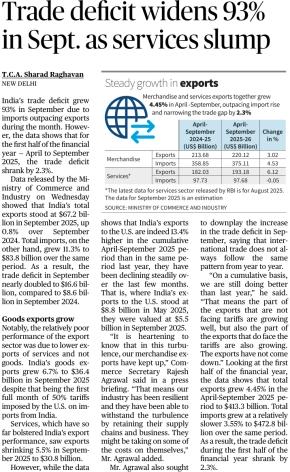
Syllabus Mapping:
- GS Paper 3 – Indian Economy: External Sector: Trade balance, export competitiveness, and current account trends, Impact of global economic policies and tariff measures on Indian exports, Government initiatives to boost exports and reduce trade deficit.
Context: India’s trade deficit — the gap between exports and imports — widened sharply by 93% in September 2025, reaching $16.6 billion, as imports surged faster than exports. The decline in services exports, traditionally a strong buffer for India’s current account, contributed significantly to this imbalance. However, on a cumulative basis (April–September 2025), the trade deficit actually narrowed by 2.3%, reflecting overall stability in India’s external sector.
What is it all about:
1. Current Trade Snapshot:
- Total exports (Sept 2025): $67.2 billion → up 0.8% YoY.
- Total imports (Sept 2025): $83.8 billion → up 11.3% YoY.
- Trade deficit: Doubled to $16.6 billion (vs $8.6 billion in Sept 2024).
2. Merchandise and Services Breakdown (April–Sept 2025): | Sector | Exports (US$ bn) | Imports (US$ bn) | % Change |
| Merchandise | 220.12 | 375.11 | Exports ↑ 3.02%, Imports ↑ 4.53% |
| Services | 193.18 | 97.68 | Exports ↑ 6.12%, Imports ↓ 0.05% |
(Source: Ministry of Commerce and Industry) Detailed Analysis:
1. Goods Exports Show Resilience:
- Merchandise exports grew 6.7% to $36.4 billion in September 2025 despite global headwinds.
- The growth came even after the U.S. imposed 50% tariffs on Indian imports — indicating the resilience and adaptability of Indian industries.
- Commerce Secretary Rajesh Agrawal noted that exporters have managed to retain supply chains and absorb tariff shocks effectively.
2. Services Sector Weakness: - Services exports, particularly in IT, business processing, and consulting, fell 5.5% in September 2025 to $30.8 billion.
- This slump has offset some of the gains from merchandise exports, highlighting India’s dependence on the services sector for trade balance stability.
3. U.S. Trade Performance: - India’s exports to the U.S. rose 13.4% cumulatively (April–Sept), though monthly exports have declined since May 2025 ($8.8 billion → $5.5 billion).
- The volatility in trade with the U.S. underscores the impact of tariff measures and geopolitical uncertainty on India’s external trade.
Broader Economic Implications: - Short-Term: The September deficit surge may temporarily pressure the current account balance and rupee stability.
- Medium-Term: The overall improvement in the first half of FY 2025–26 (trade deficit ↓ 2.3%) indicates structural robustness.
- Policy Angle: The government may consider diversifying export markets, strengthening value-added manufacturing, and boosting service competitiveness to ensure sustained external balance.
Key Takeaways: - The trade deficit doubled in September due to import surge and service slowdown.
- Cumulative trade data, however, reflects positive trends — exports up 4.45%, imports up 3.55% in H1 FY2025–26.
- India’s export base is broadening, but volatility in services and global demand remains a concern.
- The resilience of merchandise exports shows India’s capacity to withstand global tariff shocks.
UPSC Prelims: Q. Which of the following statements about India’s trade performance in FY 2025–26 is/are correct? 1. India’s overall trade deficit widened during the first half of FY 2025–26. 2. Services exports declined in September 2025 but showed positive growth over April–September 2025. 3. India’s exports to the U.S. fell sharply throughout FY 2025–26 due to tariff measures. Select the correct answer using the code below:
(a) 1 only
(b) 2 only
(c) 1 and 3 only
(d) 2 and 3 only
Answer: (b)
Night Light Data from 2013 and 2023 Reveals Limited Urban Growth in Bihar
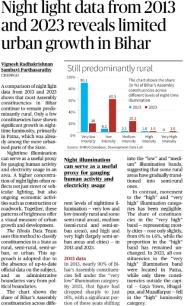
Syllabus Mapping: - GS Paper 3 – Environment and Ecology: Conservation, Sustainable Development, Climate Change Adaptation, Biodiversity.
- GS Paper 2 – International Institutions: Role of FAO in promoting global food and environmental security.
Context: A Sustainable Aquaculture in Mangrove Ecosystems (SAIME) model developed by the Nature Environment and Wildlife Society (NEWS) in West Bengal’s Sundarbans has received Global Technical Recognition from the Food and Agriculture Organization (FAO) of the United Nations.
The recognition was conferred during FAO’s 80th Anniversary Celebrations and World Food Forum in Rome, Italy.
What is it all about:
- The SAIME initiative represents an ecosystem-based, climate-adaptive, and conservation-linked livelihood model.
- It combines mangrove restoration (5–30%) with sustainable aquaculture, balancing environmental conservation and economic livelihood.
- Implemented across 29.84 hectares by 42 fish farmers, the project led to a 100% rise in average net profit due to reduced input costs.
- Farmers use mangrove litter as natural fodder for Black Tiger Shrimp (Penaeus monodon) instead of chemical feed.
- The model enhances coastal resilience, promotes chemical-free shrimp farming, and aids carbon sequestration and adaptation to sea-level rise—a major concern in deltaic regions like the Sundarbans.
About FAO (Food and Agriculture Organization): - Established: 1945
- Headquarters: Rome, Italy
- Mandate: To achieve global food security, reduce hunger, improve nutrition, and promote sustainable agriculture, forestry, and fisheries.
- Key Terms / Functions:
- Blue Transformation: FAO’s initiative to promote sustainable fisheries and aquaculture.
- Climate-Smart Agriculture: Promotes productivity while building resilience to climate change.
- Global Technical Recognition: FAO’s mechanism to acknowledge innovative practices that contribute to sustainable development goals (SDGs), especially SDG 2 (Zero Hunger) and SDG 13 (Climate Action).
Significance of the SAIME Model: - Promotes climate-smart aquaculture and mangrove restoration.
- Enhances livelihood security for coastal communities.
- Serves as a replicable global model for integrating biodiversity conservation with sustainable food production.
UPSC Prelims: Q. The “Sustainable Aquaculture in Mangrove Ecosystems (SAIME)” model, recently recognized by the FAO, aims primarily to: 1. Promote chemical-free shrimp farming 2. Enhance coastal resilience through mangrove restoration 3. Increase agricultural productivity through monocropping 4. Support carbon sequestration and climate adaptation Select the correct answer using the codes below:
(a) 1, 2 and 4 only
(b) 1 and 3 only
(c) 2 and 3 only
(d) 1, 2, 3 and 4
Answer: (a)
Aquaculture Model of Sundarbans Wins FAO Recognition
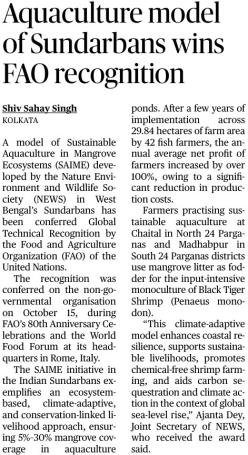
Syllabus Mapping:
- GS Paper 1 – Geography: Urbanisation, population distribution, spatial patterns.
- GS Paper 3 – Economy: Infrastructure development, inclusive growth, use of technology in data analysis for governance.
Context: A recent analysis of night light data between 2013 and 2023 highlights that most Assembly constituencies in Bihar remain predominantly rural, with only limited signs of urban growth. The study, based on data from the SHRUG Database (Development Data Lab), used satellite observations of nighttime illumination as a proxy for human activity, electricity usage, and economic development.
What is it all about:
- Night illumination serves as an important indicator for assessing the level of urbanisation, infrastructure, and energy access in a region.
- In 2013, about 90% of Bihar’s constituencies were classified under “very low intensity” illumination. By 2023, this number fell sharply to 16%, suggesting gradual progress in rural electrification and semi-urban activity.
- However, the transition has mostly been from “very low” to “low” or “medium” illumination levels—indicating semi-rural development rather than true urbanisation.
- The share of constituencies under “high” or “very high” illumination (signifying urban areas) remains extremely low—just 1.6% in 2023, concentrated mainly in Patna, with smaller urban clusters in Gaya, Bhagalpur, and Muzaffarpur.
- Overall, the findings show slow and uneven urban growth, revealing persistent rural dominance in Bihar’s economic landscape.
Significance: - Demonstrates unequal regional development and low pace of urbanisation.
- Highlights the use of remote sensing and data analytics for policy planning and tracking economic and infrastructure growth.
- Points toward the need for balanced regional urban planning and greater investment in rural electrification and infrastructure.
UPSC Prelims: Q. The “Night Light Data,” often used in developmental studies, is primarily useful for which of the following purposes? 1. Measuring levels of economic activity and urbanisation 2. Tracking deforestation and land-use changes 3. Estimating human activity and electricity consumption 4. Mapping soil and groundwater resources Select the correct answer using the code below:
(a) 1 and 3 only
(b) 2 and 4 only
(c) 1, 2 and 3 only
(d) 1, 2, 3 and 4
Answer: (a)
China Files WTO Complaint on India’s EV, Battery Subsidies
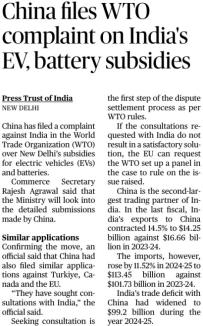
Syllabus Mapping:
- GS Paper 2 – International Relations: WTO, India–China trade relations
- GS Paper 3 – Economy: Industrial policy, subsidies, green technology trade disputes
Context: China has lodged a complaint against India at the World Trade Organization (WTO) over subsidies given to electric vehicles (EVs) and battery manufacturing, claiming they violate global trade rules by giving Indian firms an unfair advantage.
What is it all about:
- The complaint marks the first step in WTO’s dispute settlement process, where consultations are sought before setting up a dispute panel.
- India’s Ministry of Commerce has stated it will examine China’s submissions carefully.
- Similar complaints have also been filed by China against Türkiye, Canada, and the European Union, signalling growing trade tensions in the clean-tech sector.
- The issue arises amid India’s push for green industrial policy and self-reliance in EV manufacturing through domestic incentives and the Production-Linked Incentive (PLI) schemes.
Why it matters: The case underscores the global competition over clean energy technologies and raises questions about how industrial subsidies align with WTO’s non-discrimination rules in the evolving green economy.
UPSC Prelims: Q. Which of the following best describes the role of the World Trade Organization (WTO)?
(a) To regulate global carbon emissions
(b) To provide development loans to member countries
(c) To ensure fair trade practices and settle trade disputes among member nations
(d) To coordinate monetary policy among G20 nations
Answer: (c)
Live Cases Dashboard of the Legal Information Management and Briefing System (LIMBS)
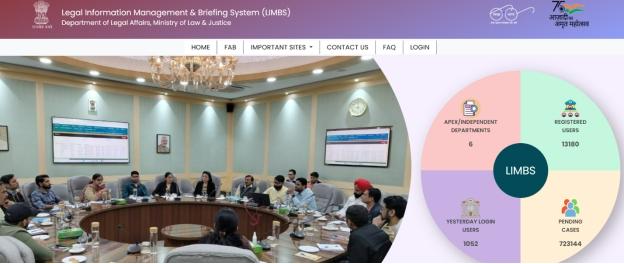
Syllabus: GS Paper 2 – Governance: E-Governance initiatives, Government Policies and Inter-Ministerial Coordination
Context: The Union Minister of State for Law and Justice has inaugurated the Live Cases Dashboard of the Legal Information Management and Briefing System (LIMBS) in New Delhi. The initiative aims to provide real-time monitoring and visualization of ongoing court cases involving various ministries of the Government of India.
Key Points:
- Objective: Designed to offer real-time data visualisation of court cases and display upcoming hearings to enhance decision-making and coordination among ministries.
- Coverage: Shows details of all cases scheduled in the next seven days in the Supreme Court, High Courts, and other courts involving Government of India ministries.
- About LIMBS: A web-based application used for monitoring all court cases where the Union of India is a party.
- Launch: LIMBS was introduced in 2016 for all ministries, departments, autonomous organisations, and CPSUs, with an advanced version launched in January 2020.
- Nodal Supervision: The system functions under the Department of Legal Affairs, Ministry of Law and Justice.
- Accessibility: It is an online tool available 24×7 to all stakeholders, including government officials, nodal officers, advocates, and arbitrators.
- Dashboard Function: Provides a comprehensive view of legal matters for each ministry or department through a user-friendly dashboard interface.
Source: DD News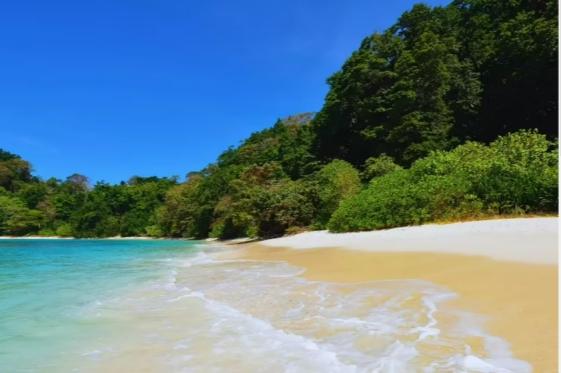
Syllabus: GS Paper 3 – Environment: Conservation, Pollution Control, and Sustainable Development
Context: Recently, five beaches in Maharashtra have been awarded the international Blue Flag Certification, recognising their cleanliness, safety, and sustainable management standards as per global norms.
Key Points:
- What It Is: Blue Flag Certification is a globally recognised eco-label awarded by the Foundation for Environment Education (FEE), Denmark.
- Purpose: It recognises beaches, marinas, and sustainable tourism boats that meet high standards of cleanliness, beauty, and environmental sustainability.
- Origin: The programme was launched in France in 1985 and extended beyond Europe in 2001.
- Criteria: To qualify, beaches must meet 33 stringent parameters under four main categories – water quality, environmental management, environmental education, and safety.
- Mission: The Blue Flag Mission promotes sustainability in tourism through environmental education, protection, and sustainable development practices.
- Significance for India: Apart from the newly added beaches in Maharashtra, other Indian beaches with Blue Flag status include Shivrajpur (Gujarat), Ghoghla (Diu), Kasarkod & Padubidri (Karnataka), Kappad (Kerala), Rushikonda (Andhra Pradesh), Golden (Odisha), Radhanagar (Andaman & Nicobar), Kovalam (Tamil Nadu), Eden (Puducherry), Minicoy Thundi and Kadmat (Lakshadweep).
Source: News On Air
India Elected for United Nations Human Rights Council (UNHRC)
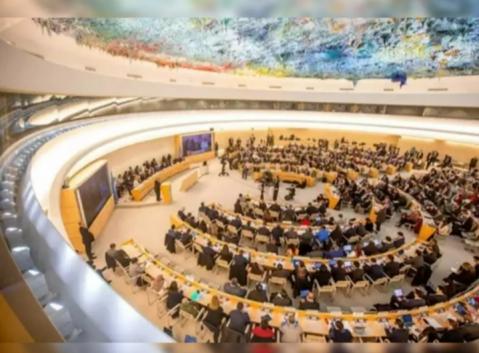
Syllabus: GS Paper 2 – International Relations: United Nations and Global Human Rights Institutions
Context: India has been elected unopposed to the United Nations Human Rights Council (UNHRC) for the 2026–2028 term, marking its seventh tenure on this global human rights body.
Key Points:
- About UNHRC: It is the principal intergovernmental body of the UN responsible for promoting and protecting human rights worldwide.
- Establishment: Created in 2006 by the UN General Assembly, replacing the former UN Commission on Human Rights to enhance the credibility of global human rights mechanisms.
- Headquarters: Located at the United Nations Office in Geneva (UNOG), Switzerland.
- Mandate: Promotes universal respect for human rights, addresses violations, and makes recommendations for protection through dialogue and cooperation.
- Functions:
- Conducts Universal Periodic Reviews (UPR) of all UN Member States.
- Appoints Special Rapporteurs and Working Groups to monitor human rights issues.
- Adopts resolutions and authorizes fact-finding missions on global crises.
- Serves as a platform for dialogue among governments, NGOs, and civil society.
- Membership and Election:
- Comprises 47 Member States elected by the UN General Assembly through secret ballot.
- Members serve three-year terms; one-third of seats are renewed annually.
- Regional distribution: Africa (13), Asia-Pacific (13), Latin America & Caribbean (8), Western Europe (7), Eastern Europe (6).
- States can serve a maximum of two consecutive terms.
- India and UNHRC:
- India’s previous terms: 2006–07, 2011–14, 2014–17, 2017–20, 2022–24, and now 2026–28.
- India actively advocates inclusive development, digital rights, gender equality, and multilateral cooperation in human rights forums.
Source: News On Air
National Critical Mineral Stockpile (NCMS)
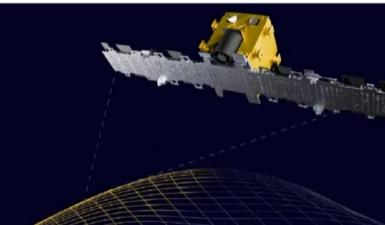
Syllabus: GS Paper 3 – Economy & Environment: Energy, Mineral Resources, and Strategic Reserves Context: The Government of India is planning to establish the National Critical Mineral Stockpile (NCMS) to secure the nation’s supply of rare earth elements (REEs) and other critical minerals vital for green technologies such as electric vehicles, wind turbines, and defence systems. Key Points:
- What It Is: The NCMS is a strategic initiative under the National Critical Minerals Mission (NCMM) aimed at ensuring long-term supply security of rare earths and other essential minerals.
- Background: China currently controls over 70% of global rare earth production, and its export restrictions on rare earth magnets have raised global concerns about supply chain vulnerability.
- Purpose for India: Supports India’s goals in clean energy transition, electric mobility, and self-reliant manufacturing, reducing dependence on foreign mineral imports.
- Objectives:
- Create a two-month reserve of key rare earths and strategic minerals.
- Encourage private sector participation in stockpiling and management.
- Support domestic production of rare earth magnets and critical mineral processing.
- Act as a buffer mechanism against market shocks, export curbs, or geopolitical tensions.
- Phased Implementation:
- Phase I: Focus on rare earth elements.
- Later Phases: Include lithium, cobalt, nickel, graphite, and titanium, essential for batteries, semiconductors, and renewable energy technologies.
Source: PIB
Mission Drishti Syllabus: GS Paper 3 – Science and Technology: Space Technology, Innovation, and Start-ups Context: Bengaluru-based space-tech start-up
GalaxEye will launch the
world’s first multi-sensor Earth Observation (EO) satellite, “Mission Drishti”, in the
first quarter of next year, marking a major milestone in India’s private space sector.
Key Points: - What It Is: Mission Drishti is the world’s first multi-sensor Earth Observation satellite and India’s largest privately built satellite.
- Developer: Planned and developed by GalaxEye, a Bengaluru-based space start-up.
- Technology: Equipped with Synthetic Aperture Radar (SAR) and high-resolution optical payloads for all-weather, day-and-night imaging.
- Design Goal: Optimised for spatial, spectral, and temporal resolutions to provide high-precision imagery.
- Deployment Plan: GalaxEye aims to deploy 8–12 satellites by 2029 under this mission.
- Specifications: Weighs 160 kg and offers 1.5-metre resolution imaging capability.
- Testing: Successfully passed structural tests at ISRO’s U R Rao Satellite Centre, proving its durability in extreme space conditions.
- Applications: Useful for border surveillance, disaster management, defence, infrastructure monitoring, agriculture, financial and insurance assessments, and other geospatial analyses.
Source: The Hindu












